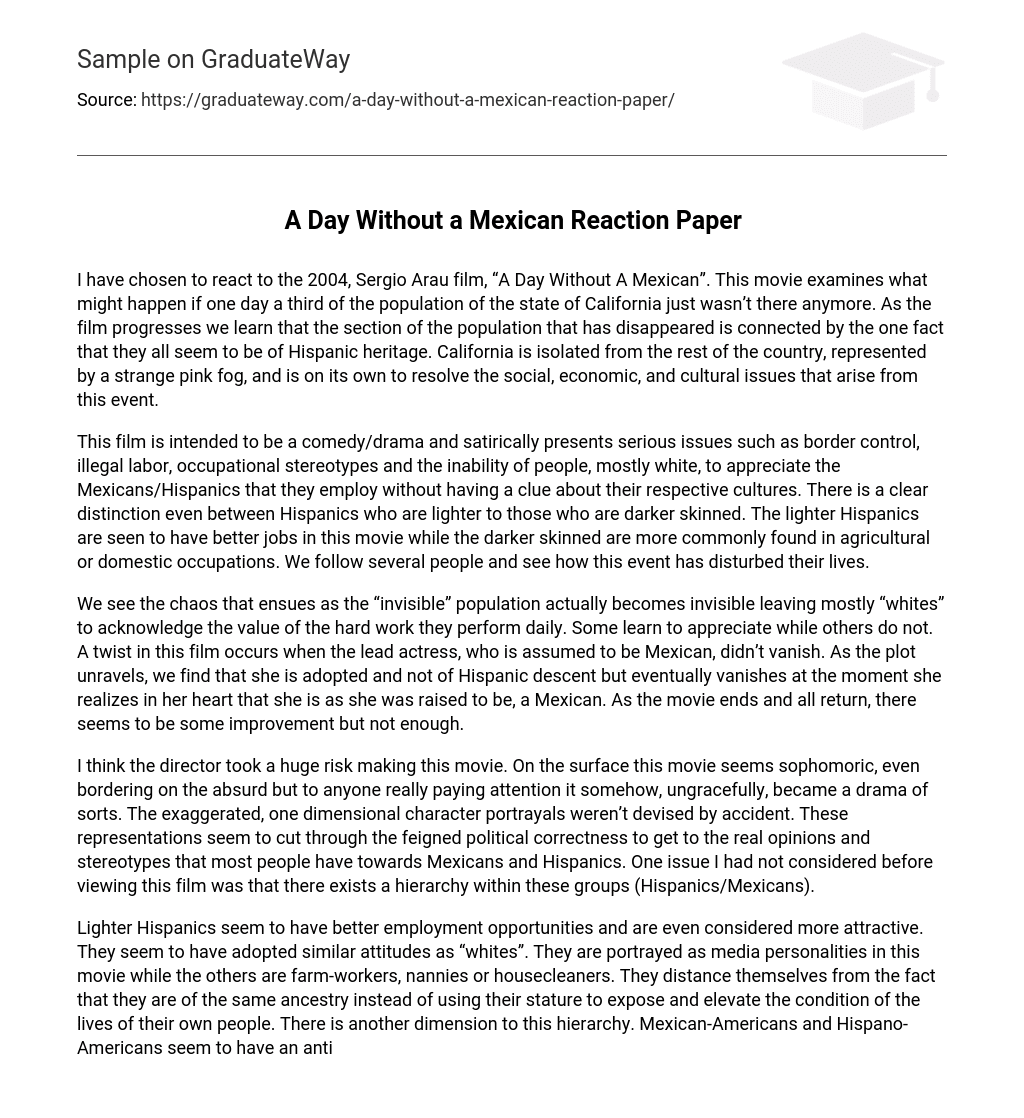I am choosing to analyze the film “A Day Without A Mexican” (2004) directed by Sergio Arau. This movie delves into the aftermath of a sudden disappearance of one-third of California’s population. Interestingly, all the missing individuals are of Hispanic heritage. The state is isolated from the rest of the country due to a unique pink fog, compelling them to confront and resolve various social, economic, and cultural challenges that emerge.
The film aims to blend comedy and drama as it satirically explores important topics like border control, illegal labor, occupational stereotypes, and the lack of understanding towards Mexicans/Hispanics employed by clueless white individuals regarding their cultures. The movie highlights a noticeable contrast between lighter-skinned and darker-skinned Hispanics, as the former tend to hold better jobs while the latter are often seen in agricultural or domestic roles. Through following various characters, we witness how this event disrupts their lives.
We witness the chaos that arises when the “invisible” population actually becomes unseen, leaving primarily “whites” to acknowledge the value of their daily hard work. Some individuals learn to appreciate this, while others do not. However, an unexpected twist occurs in the film when the main actress, initially presumed to be Mexican, does not disappear. As the story unfolds, it is revealed that she is actually adopted and does not have Hispanic heritage. Nonetheless, she ultimately vanishes when she realizes in her heart that she identifies as Mexican, reflecting the way she was raised. The movie concludes with a partial improvement as everyone reappears, but it is still not enough.
I believe the director took a bold gamble in creating this film. Although it may appear superficial and even ludicrous at first glance, those who truly focus will discover that it unexpectedly transforms into a kind of drama. The deliberate and simplistic way the characters are portrayed was not accidental. These depictions seem to penetrate the facade of political correctness, revealing the genuine opinions and stereotypes held by the majority towards Mexicans and Hispanics. One aspect that hadn’t crossed my mind before watching this movie was the existence of a hierarchy within these ethnic groups.
In the film, light-skinned Hispanics are presented as having better job opportunities and being perceived as more attractive. They have adopted similar attitudes to those of “whites”. Meanwhile, other Hispanics are shown in roles such as agricultural laborers, caretakers, or domestic workers. Rather than using their influence to raise awareness of and enhance the situation for their own community, they distance themselves from their shared heritage. This hierarchy also uncovers a hostility among Mexican-Americans and Hispano-Americans towards individuals who were not born in or currently reside in the country illegally.
I am perplexed by this. As I pondered over the meaning of the pink fog enveloping and surrounding the state of California, it dawned on me that it served a similar purpose as the barrios (neighborhoods). It segregated and confined those who stayed behind after the Mexicans vanished, much like how the barrios isolate and contain unnoticed individuals. It wasn’t a physical barrier, but whatever lay on the opposite side was both terrifying and concealed. The unknown behind that barrier was obscured by apathy. It would have been simple to merely pass through it, potentially ending the fear and indifference.
In this movie, my favorite points were about personal identity and self-image. It was intriguing when Lila Rodriguez, the news reporter, was the only Mexican who didn’t vanish. At first, I, along with many characters in the film, believed she would be the savior for an entire race. However, when I discovered she wasn’t of Mexican descent, I already glimpsed the movie’s intended direction. Our true identities are shaped by our beliefs and convictions. Hence, it came as no surprise when Lila disappeared. In that very moment, the possibility of uniting as a collective people and blurring the boundaries between us was conceived.
The humor in this film was intentionally simple, with a clear premise. The movie addressed the complicated problems in our country while remaining straightforward. It is true that Mexicans and Hispanics are some of the hardest working people driving the American economy. Sadly, it is also undeniable that they receive the least respect, admiration, and fair pay for their valuable contributions. The lack of acknowledgment for a significant portion of the population who care for our children, cook our meals, work in difficult conditions for long hours, and receive insufficient compensation is both shocking and disgraceful.
These individuals have done so much for us, and if they were to depart from our lives, we would rightly deserve the consequences. Our existence would be thrown into chaos as we struggled to provide for ourselves, just as they have tirelessly provided for us. While the comedic elements in this movie weren’t always enjoyable, they allowed us to witness firsthand the impact we have on the lives of Mexicans and Hispanics, free from any distractions of special effects or intricate storylines. Their efforts surpass what has been acknowledged, and they warrant better treatment. Undoubtedly, I have acquired knowledge from this encounter. Your performance on this assessment is 50/50. Exceptional work!





